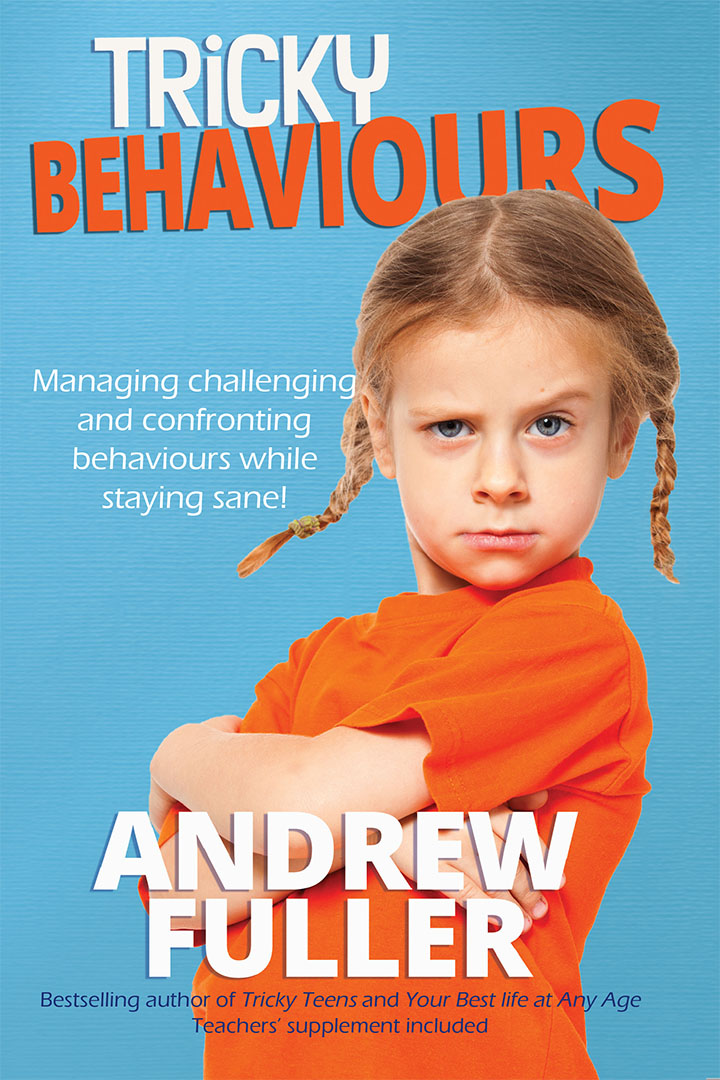
In this extract from his new book Tricky Behaviours, leading adolescent psychologist Andrew Fuller offers strategies for parents to help their tricky kid navigate the tricky world of peer pressure. Plus watch a video of parents taking Andrew's parents Pledge.
The friends your tricky kid chooses to mix with may not always be the ideal comrades you were hoping for. The solution is for your child to have diverse friendship groups.
The secret world
Parenting is different and scarier these days because there is a world of peer pressure that occurs outside the inkling of adults. Mobile phones, email, messaging and texting are almost impossible to keep track of.
Many tricky kids have two worlds: the world of peers where they need to be cool, compact and calculating; and the world of family, where they can still be young and make mistakes. Parents shouldn’t expect tricky kids to behave with their peers in the same way they behave with them.
The rule of the 3 Fs
The absolute first thing to do is to get to know their peers. Knowing them and, if you can, their parents places you in a much more powerful position. Find them, feed them and (be) friend them.
Don’t forget that peer-group pressure can be positive as well as negative. Having a strong positive link with a few key players in your child’s life increases the chances that the pressure will be positive.
Peer pressures parents worry about
‘Are you still a virgin?’
‘Try this drug, it’s cool.’
‘How about we borrow this car and go for a midnight drive?’
‘You’re fat, go on a diet.’
‘You’re ugly.’
‘It’s cool to muck around at school.’
It’s enough to keep any parent awake at night. The world of friendship for many children is, in reality, a world of ruthless, vindictive, nasty competitiveness. People will say horrible things to your child, especially if he is a tricky kid.
Tricky kids who are the feistiest can also be the most susceptible to the pressures and influences of others. Teach your child to differentiate opinion from reality. Talk about opinions you have that most people probably don’t share. Ask your child to describe an opinion he has, and discuss whether it is reality.
For example:
‘What is your favourite colour?
‘Do you think everyone in the whole world has that colour as their favourite? (Hopefully they say ‘No’, but if they says ‘Yes’, say, ‘Ok, let’s do a survey, and ask ten people’.)
‘So if you were to say that [your favourite colour] was the best colour, what would happen? Most likely, some people would agree and others would disagree. Your favourite colour is just your opinion, and their favourite colour is just their opinion. Most opinions are like that.’
Another exercise I often do with kids who are concerned about what people think of them is to get a series of photos of people from magazines and ask them to score those people out of 10 for beauty, and then ask them to compare that with how other people might rate them.
Trying to get them to see that beauty is just an opinion is not always easy, but the aim is to at least get them to understand that not everything other people say is true.
Say to your tricky kid, ‘Don’t believe everything that other people say about you. If you are really worried, check it out by asking others.’
Peer pressure at different ages
Belonging is the driving force behind peer pressure, and it can be either healthy or distorted. During the preschool years, children engage in independent play, so there is generally little peer pressure. The tasks of sharing toys and attention are the two main issues at this stage.
During primary school, there are often clusters of friendships, with boys and girls usually in different groups. There will be a strong awareness of who gets invited to parties and for sleepovers.
Early high-school years see friendship clusters – girls’ groups are tighter, more exclusive and more status-conscious than boys’. The degree of the child’s physical development is important here. A survey of school students about words they associate with popularity is revealing:
| Age | Boys | Girls |
| 17 | Friendly Influential Cool | Friendly Confident Nice |
| 16 | Friends Leader Friendly | Friends Happy Outgoing |
| 15 | Me Friends Cool | Nice Friendly Friend |
| 14 | Friends Sex Drugs | Attractive Friends Boys |
| 13 | Cool Friends Attractive | Friends Attractive Cool |
| 12 | Cool Well-known Friends | Attractive Friends Fashionable |
| 11 | Friends Cool Kind | Pretty Friends Cool |
| 10 | Cool Funny Friends | Friends Pretty Cool |
| 9 | Cool Liked Clever | Cool Liked Clever |
| 8 | Cool Playful Great | Cool Friends Clever |
| 7 | Cool Liked Famous | Friendly Special Liked |
| 6 | Kind Nice Helpful | Kind Helpful Pretty |
Apart from showing how powerful perceived prettiness is even at age six for girls, the table also indicates that popularity in the later teen years has more to do with social skills and confidence than appearance.
Diversify
Alongside knowing your child’s peers as a way of countering negative peer pressure, is diluting that pressure. Ensuring that your tricky kid has a range of friends not only contributes to her resilience, but also means she is less likely to be led astray by a few others.
Strategies for diversifying the peer group include travel, youth groups, broadening your connection with your extended family, changing schools and, in some cases, moving away from the area you live in.
Peer pressure and the different types of tricky behaviours
Parents often speak about the sorts of negative peer pressure that affect their tricky kid. Let’s look at these.
Manipulators
Manipulators can be the source of negative peer pressure on others. Teach them to be direct in their dealings with others. Have a zero-tolerance approach to rumour-spreading, bullying or talking behind others’ backs.
Negotiators
Negotiators are often regarded as ‘cool’ by others. Divide and conquer: never negotiate with them in front of their peers.
Competitors
The pressure that Competitors feel to be better than anyone else can lead to loneliness and vulnerability to taunts and bullying from others. Help them to differentiate between fair-weather and true friends.
Debaters
Peers can usually play Debaters like a fiddle. Debaters’ natural courage can lead them into battle on behalf of the insincere.
Dare Devils
Oh, dear! A gaggle of Dare Devils hanging out together is a recipe for parental anxiety. Try to make sure your Dare Devil has a variety of friends, including some calmer types. When Dare Devils do mix with other Dare Devils, make sure it is in structured situations, such as organised sport.
Passive Resisters
One special friend can make all the difference to a Passive Resister. These tricky kids may associate for a time with younger peers. Try to give them a mix of ages to socialise with, including your own friends.
Getting to know their peers
Get to know their peers by using the rule of the ‘3F’s’:
Find them.
Feed them.
(Be)Friend them
Like this post? Please share using the buttons on this page.

About the book
Andrew is a clinical psychologist specialising in the wellbeing of young people and their families.
Stay in touch with Andrew on Facebook, on LinkedIn. More tips about how to maximise your success can be found at:
Andrew’s websites
www.andrewfuller.com.au
www.mylearningstrengths.com (45,000 young people in the past year discovered their learning strengths and found how to increase success and motivation).
Books for parents
Tricky Conversations
Tricky Teens and Emerging Adults: A survival guide for parents
Unlocking Your Child’s Genius: How to discover and encourage your child’s natural talents
Books for teachers
Guerilla Tactics for Teachers: The Essential Classroom Management Guide
Work Smarter, Not Harder: Study skills for students who dislike homework
Tricky Conversations: How to have less conflict and more peace in your life
Neurodevelopmental Differentiation: Optimising Brain Systems to Maximise Learning



